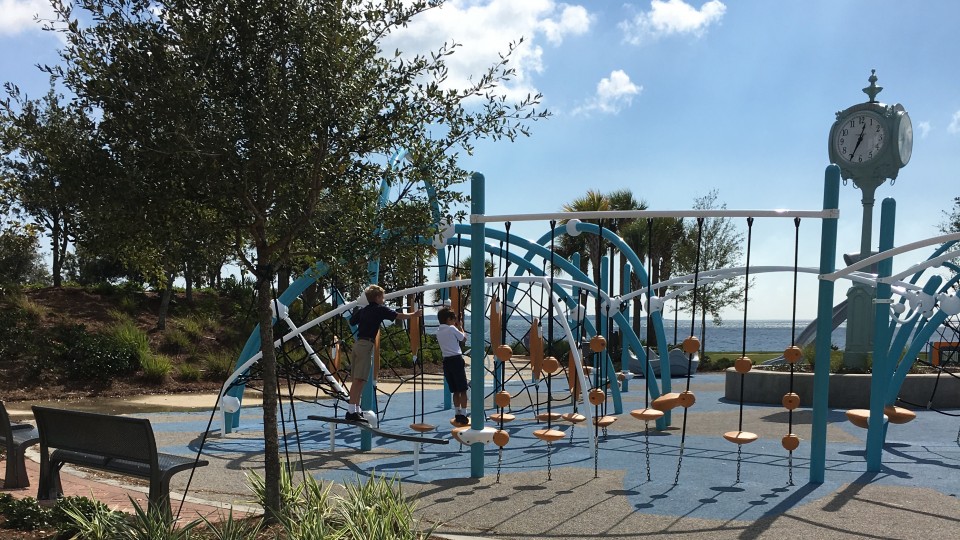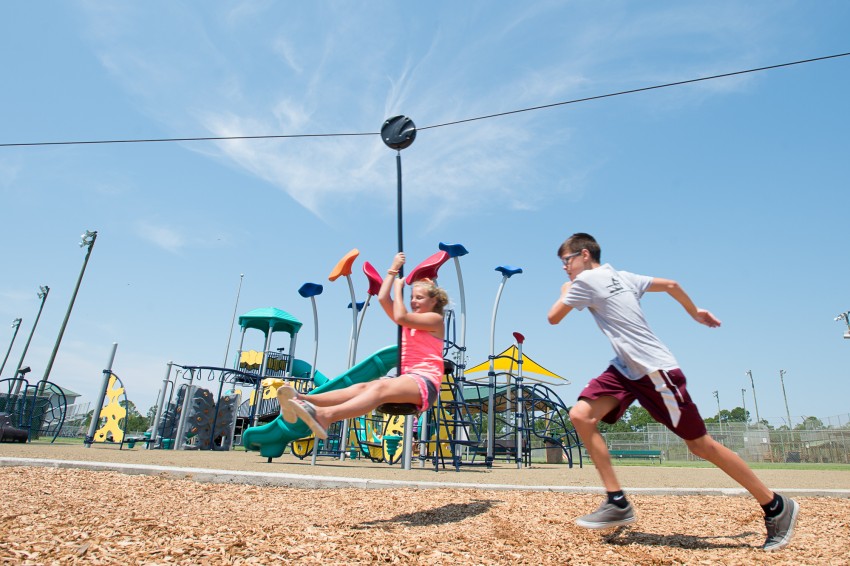Shannon's Window: The power of play to build brains
- June 10, 2016
- / Shannon Nickinson
- / education

The Rotary Centennial Playground at the Community Maritime Park in downtown Pensacola. Photo credit: Shannon Nickinson
The move from preschool to kindergarten is a big one.
With kindergarten comes more “big kid” stuff than many preschoolers are used to — including homework, tests, and more structured learning. But there’s something else that changes.
Call it the Big Slowdown: Trading the movement and unstructured play-based learning of preschool for alot more sitting still and worksheets.
For many children, frequent trips for outside and free play are replaced with 20 minutes of recess and physical education twice a week. For the ones whose first exposure to the classroom is kindergarten — those who don’t have a voluntary prekindergarten or other preschool experience before they come to public school — the hurdle can be even higher.
Of the nearly 500 submissions to the Be the Bulb early learning challenge, a handful of ideas that stood out to me all touched on this mind-body connection — and how we are eroding it for students at the time in their lives when they benefit from it the most.
As the academic expectations of kindergartners have risen in recent years, one of the casualties has been two things that scientists and researchers increasingly note are vital to building young minds.
Movement and play.

Children play at the all-inclusive playground at the Navarre Sports Complex designed for children meeting the requirements of the American with Disabilities Act Monday, August 3, 2015. (Michael Spooneybarger/ Studer Community Institute)
Texas Christian University is conducting a research project to gauge the effect of more frequent recess periods on children in grades K-2. A recent episode of the TED Radio Hour podcast was devoted entirely to the concept of play, how it impacts social and physical development, and the harm its absence can do.
One of the talks excerpted in that podcast is from Dr. Stuart Brown, founder of the National Institute for Play, who came to the church of play by one of the most seemingly unlikely paths.
Brown was a psychiatrist at Baylor University when he was asked to be part of a team to research Charles Whitman, the former Marine sharpshooter who in 1966 murdered his mother and wife, then took to the Tower on the University of Texas at Austin campus. From there, Whitman shot 49 people – 17 fatally.
The scientists who studied Whitman’s childhood, including Brown, found that the absence of normal developmental play in his life — at the hands of an abusive father — stunted him. It fed, they found, Whitman’s sense of isolation, lack of empathy, and his inability to find ways to relieve the stress he felt without resorting to violence.
Ultimately, Brown took “play histories” of people convicted of murder. What they all lacked was play deprivation. The lessons most of us learn from playing — that you don’t always win, that you have to get along with others to get along in life, negotiation, social cues, how to work and play well with others — escaped these people.
Brown studied play in animals as well. He found that play is a crucial way for animals and humans learn the “rules of the road” when it comes to problem solving, social interaction, and brain development.
Wire up a mother and an infant to an electroencephalogram device and you can see, Brown says, their brains light up when they play together.
“What does play do for the brain? A lot,” Brown says in his TED Talk. “Nothing lights up the brain like play.”
That “lit up” brain link is key to the Thirty Million Words Initiative at the University of Chicago. The “Tune In” pece of Dr. Dana Suskind’s overall blueprint to boost the number of words young children hear encourages parents to tune in to what their children are playing with or focused on — and to build learning and vocabulary into that.
Pretend play and the creativity that goes with it are highlighted in Suskind’s book as a way to build a child’s vocabulary, enhance social skills, and build higher order thinking.
It’s hard to get those lessons if you don’t get to move around.
“Play is practical and it’s very important,” Brown says. “Rough and tumble play is a great learning medium for all of us. Preschool children should be allowed to dive, hit, whistle, jump, scream, be chaotic and develop through that emotional regulations, and social byproducts, cognitive emotional and physical that come… of that.”
Children learn best by doing. Everyone does.
Good kindergarten teachers work movement into their classrooms wherever they can. They sing songs, keep centers for play and make time when they can for their young charges to “get the wiggles out.”
They need the support and encouragement to do that — and more.
We, the adults in the education continuum, need to remember that as we think about what it would take to make Pensacola a community that weaves early learning into its civic soul.
All work and no play does more than make Jack a dull boy. It makes Jack’s brain dull.
 CivicCon launches with a look at good growth in cities
CivicCon launches with a look at good growth in cities
 Building stronger brains one baby, one parent at a time
Building stronger brains one baby, one parent at a time
 SCI debuts commercial on Early Learning City
SCI debuts commercial on Early Learning City
 Entrecon: World class speakers and an opportunity to sharpen skills
Entrecon: World class speakers and an opportunity to sharpen skills
 PYP Quality of Life survey 2017
PYP Quality of Life survey 2017
 EntreCon Pensacola 2016: A look back
EntreCon Pensacola 2016: A look back
 Leadership tip: getting better employee takeaways
Leadership tip: getting better employee takeaways
 Leadership tip: be interested instead of interesting
Leadership tip: be interested instead of interesting
 Leadership tip: delivering difficult messages
Leadership tip: delivering difficult messages
 Brain Bags boost Arc, Early Childhood Court programs
Brain Bags boost Arc, Early Childhood Court programs